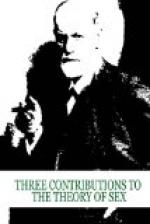Conclusion.—Though from the material on hand we are by no means in a position satisfactorily to explain the origin of inversion, we can say that through this investigation we have obtained an insight which can become of greater significance to us than the solution of the above problem. Our attention is called to the fact that we have assumed a too close connection between the sexual impulse and the sexual object. The experience gained from the so called abnormal cases teaches us that a connection exists between the sexual impulse and the sexual object which we are in danger of overlooking in the uniformity of normal states where the impulse seems to bring with it the object. We are thus instructed to separate this connection between the impulse and the object. The sexual impulse is probably entirely independent of its object and is not originated by the stimuli proceeding from the object.
B. The Sexually Immature and Animals as Sexual Objects
Whereas those sexual inverts whose sexual object does not belong to the normally adapted sex, appear to the observer as a collective number of perhaps otherwise normal individuals, the persons who choose for their sexual object the sexually immature (children) are apparently from the first sporadic aberrations. Only exceptionally are children the exclusive sexual objects. They are mostly drawn into this role by a faint-hearted and impotent individual who makes use of such substitutes, or when an impulsive urgent desire cannot at the time secure the proper object. Still it throws some light on the nature of the sexual impulse, that it should suffer such great variation and depreciation of its object, a thing which hunger, adhering more energetically to its object, would allow only in the most extreme cases. The same may be said of sexual relations with animals—a thing not at all rare among farmers—where the sexual attraction goes beyond the limits of the species.
For esthetic reasons one would fain attribute this and other excessive aberrations of the sexual impulse to the insane, but this cannot be done. Experience teaches that among the latter no disturbances of the sexual impulse can be found other than those observed among the sane, or among whole races and classes. Thus we find with gruesome frequency sexual abuse of children by teachers and servants merely because they have the best opportunities for it. The insane present the aforesaid aberration only in a somewhat intensified form; or what is of special significance is the fact that the aberration becomes exclusive and takes the place of the normal sexual gratification.
This very remarkable relation of sexual variations ranging from the normal to the insane gives material for reflection. It seems to me that the fact to be explained would show that the impulses of the sexual life belong to those which even normally are most poorly controlled by the higher psychic activities. He who is in any way psychically abnormal, be it in social or ethical conditions, is, according to my experience, regularly so in his sexual life. But many are abnormal in their sexual life who in every other respect correspond to the average; they have followed the human cultural development, but sexuality remained as their weak point.




